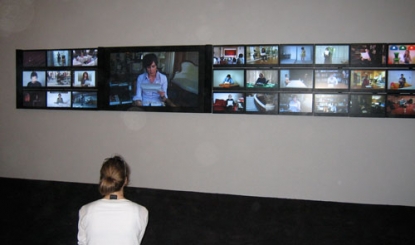Feature: Reviews
Sophie Calle at the Venice Biennale
- June 10 - November 21, 2007
My vote for the Golden Lion goes to the French Pavilion at the Venice Biennale. Sophie Calle has collaborated with 107 other women to produce Take Good Care of Yourself, a very ambitious (albeit very text heavy) project that fills the entire pavilion.
How cowardly is it of someone to initiate a break up with a letter? Actress Jean Moreau picks up on just how cowardly this is as she reads a break up letter that Sophie Calle has received. Moreau reads the letter out loud while sitting at a table and smoking, stops every few lines and offers her own running commentary. The letter is short, one page, non-apologetic, and self-pitying. It basically frees the writer to pursue other affairs. It alludes to a clean break, with no further contact, making it seem as though Calle would prefer it that way. The letter ends with the sentence: “Take good care of yourself.” Frustrated at the casualness of how the break is orchestrated, and rendered mute by his words, Calle decides that the best way to take care of herself is to contact 107 women she admires and have the women offer their responses to the letter. She then documents these responses in her collaborators’ media of choice: either text, photography, or print, and hangs them alongside photos of each of the women reading the letter.
These 107 women form a diverse group, in not only age, but also in nationality, background and occupation. Their interpretations of the letter are wildly divergent, varying from a straightforward reading, in various languages, such Jean Moreau’s, to more offbeat interpretations such as an aria composed by an operatic singer, to a puppet show performed for a group of children (the puppets read the letter aloud) to an interpretive Indian dance. My favorite response, however, is one performed by a talking parrot. The parrot has been taught to repeat the letter, word for word. After squawking out a few intangible phrases however, she (I’m guessing it’s a she because all of these collaborators are female) decides she’d rather eat the letter, tearing it into shreds and appearing to take great relish in consuming it bit by bit.
The collaborators who are actresses, comedians, dancers, songwriters and musicians (Peaches and Laurie Anderson among them) have chosen the format of the video in order to capture their interpretive responses, and their videos are presented side by side on wall filled with flat screens. One large flat screen with audio highlights one video at a time, scrolling through a selected program of individual videos. In another room, some other videos are presented as a two-channel projection, but it is unclear why these other videos have been separated into different room and presented in this more prominent format.
Other collaborators have chosen to write out their responses in print, and these texts are enlarged and hung on the wall next to the collaborators’ photographs. There is also a booklet with English and Italian translations of all the texts that the viewer can take with them if they tire of reading inside the gallery. A journalist writes about why this breakup letter will never be published in a newspaper (because no one has died over it). A physicist analyzes the nature of brittle fractures caused by various applications of stress. A criminologist concludes that the writer of the letter is “a manipulator, a seducer, whose relationships with others are based on domination and ascendancy.” Calle’s mother writes a somewhat consoling yet sobering letter telling Calle not to “over dramatize” and reminds her that this “love” lasted only three or four seasons. She concludes by suggesting that it could be the “wellspring” of a new art project—An insightful prediction.
Calle seems to be conscious of the fact that her project may be read as being too facile and obvious in its intent to man bash (gathering together a group of women to jeer at the actions of a flawed man). But her decision to include a text that is critical of the project as a whole saves it from this narrow read. Christine Angot, whose occupation is just described as “writer,” directs her criticism toward Calle rather than the man who wrote the letter: “If Sophie had loved him as much as she said, she wouldn’t have summoned a whole squadron of women to help her get over it. She would have tried to get over it, you have to, but not like that… with our pathetic texts, or our interpretations, our performances, pitting ourselves against the man, the better to chase him out and make him small.”
It’s hard to know how much Calle loved this man. Does the number 107 reflect the magnanimity of her love? Does the scale and length of the project’s duration, and the number of collaborations she solicited reflect the time it took for her to mourn this loss, to get over it, and to move on? Or at some point in the process (maybe it was very early on, as she was developing the concept?) did the initial motivation for the project become arbitrary? How quickly did the talents, insights and witticisms of her collaborators distract her and help her forget the man who dumped her? Although the viewer may be tempted to ask these questions, after taking the time to consider this project, it becomes moot just how genuine Calle’s love really is or was. This project’s aim is much more universal. Take Good Care of Yourself comes across as a celebration of the women in Calle’s life; women whose achievements have helped her realize her own creative potential; women who are so infinitely beautiful in their own individual way, that they accentuate the beauty of others around them. And Calle has successfully pieced together a more esteemed and worthy sense of her self in their midst, one that may even win her the Golden Lion.

